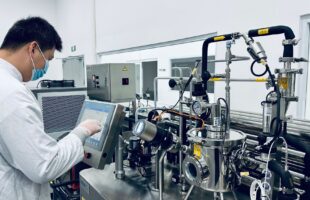
In the past few decades, the global production of meat and poultry products has doubled; it is projected to grow in the coming years, as the consumption of meat has been constantly increasing because of rapid economic growth, especially in developing countries. Meat & poultry products are a part of the normal diet in developed countries, whereas, in developing countries, they are used as substitutes of bread and low-cost foods.
The global meat industry produced about 336.4 million tonnes of output in 2018—an increase of 1.5 percent from 2017—recording the highest growth since 2014. On the other hand, the world’s poultry meat output increased by 1.3 percent in 2018 to reach a volume of 123.9 million tonnes, as per the Food and Agriculture Organization (FAO). The meat market overview published by the FAO in 2018 mentions that the market for bovine meat is likely to grow at the highest rate, in terms of value, followed by pig meat, poultry, and ovine markets. However, in terms of volume, the market for pig meat is growing, followed by poultry, bovine, and ovine meat markets.


Meat & Poultry Food Applications Introduced by Fast-food Chains and Restaurants
Meat & poultry products form an important part of the regular diet in most of the countries. Owing to this, raw meat has been the primary product of the global meat industry for decades. However, the market scenario has changed; several applications such as ready-to-eat meat, frozen meat products, processed meat, and meat desserts have significantly established their market positions and have been in demand all over the world.
In developed countries such as the US, Canada, and the UK, processed meat, such as bacon, ham, sausages, salami, corned beef, jerky, canned meat, and meat-based sausages are consumed at a large level. Further, the humongous popularity of fast food meat products offered by Subway, McDonald’s, Taco Bell, Burger King, and Pizzahut has been the major driving force behind the wide consumption of a variety of meat products as well as the success of meat processing and fast food companies in these countries. These fast-food players have effectively established themselves in various emerging nations of Asia, which includes India, China, Thailand, and Indonesia. As a result, processed and fast food meat products have become mainstream products in Asian countries as well.
Meat products have always been observed to be an integral part of people’s diets for several decades. However, their use in the dessert category is being experimented. In the past decade, it has been noticed that several restaurants across the US are producing desserts by incorporating meat in them. Bacon Chocolate Crunch Bar at Animal in LA; Foieffles at Barmini; Rubber Duckies at Minibar in DC; Maple Glazed Bacon Apple Doughnut at Dynamo Donuts in San Francisco; and Ice Cream Sandwich a la Méat at Goldis Sausage Company in Austin are some of the examples of the types of meat desserts offered by various companies in the US.
Factors Driving the Consumption of Meat and Meat Products
Factors such as the adoption of new lifestyle trends; consumer perception about the high protein content of meat products; rapid urbanization and growth in the foodservice & retail industries have been driving the demand for processed meat products globally.
Besides, good management practices, streamlined production processes, and the use of new technology for preservation and packaging expanded the meat output volume in all the major regions of the world, especially in Europe and North America.
All these factors are projected to ensure that a constant rise in the demand for meat and poultry products is achieved in the coming years.
A major rise in animal slaughter for meat was noticed in 2018 due to droughts in some parts of the world—in the US in the first half of the year; the European Union during the summer months; and Australia almost throughout the year.
Demand, Export, and Import Scenario (2018)
As per Food and Agriculture, across the various types of meat, bovine meat output registered the highest growth, with +2.1 percent; it was followed by poultry meat with +1.3 percent growth. However, the outputs for ovine meat and pig meat remained at +0.6 percent.
The volume of global meat exports in 2018 was 33.8 million tonnes—an increase of 2.9 percent from 2017. This upsurge is principally driven by the increased shipments from the US, Australia, Argentina, and the European Union. China remains the world’s largest meat importer. The country increased its purchases significantly, as the consumer demand for meat continued to rise amid a contraction in pig meat output, partly, due to the onset of the African swine fever. On the other hand, India’s exports in 2018 were curtailed, mainly resulting from the shutting down of slaughterhouses in Uttar Pradesh, a key meat processing state, and difficulties in transporting animals for slaughter.
Furthermore, an increase in imports has been observed in the Republic of Korea and Vietnam; while the Russian Federation, Saudi Arabia, and the US have cut back on imports.

Challenges for the Global Meat Industry
Availability of Meat Analogues
The presence of meat analogues or alternatives is presenting various challenges for the global meat industry. The concept of cultured meat is in the development phase and is soon expected to be introduced in the market. The development of sustainable methods for large-scale meat production by cellular agriculture is compelling the investors and a handful of start-up companies, such as MosaMeat, Memphis Meats, and Super Meat, to grow “clean meat” or “cultured meat”. This technology has attracted the interest of the world’s leading meat giants such as Tyson food and Cargill, along with billionaires, such as Richard Branson and Bill Gates. These factors have led to the development of the cultured meat market.
On the other hand, plant-based meat has been introduced globally, and the market is growing at a notable rate. Plant-based meat products are meat substitutes derived from plant sources such as soy, wheat, and pea. They mimic the characteristics of animal-based meat, in terms of taste and texture.

Industrialized animal agriculture has been intensively impacting the environment, human health, and animal welfare over the past several decades, which has led to serious environmental issues, such as an increase in greenhouse gas (GHG) emissions. Thus, government bodies across the globe have started paying more attention to sustainable solutions to the issues related to meat consumption and the associated adverse effects. For instance, in 2016, the Chinese government outlined a plan to reduce the consumption of meat per person by 50%. Also, Good Food Institute (GFI) has significantly invested in various universities across the US to develop and evolve plant-based meat products. Some of these universities are Cornell University; the University of California, Davis; and the University of Minnesota.
Environmental Concerns
Environmental issues caused by livestock farming is another big obstacle to the growth of the meat industry. Animal agriculture is disturbing the atmospheric balance of the earth, as it contributes about 14.5% of the total greenhouse gas emissions (as per Environmental Protection Agency). As a result, there is a gradual increase in the use of sustainable food solutions to cater to the constantly increasing population and meat demands.
Besides, the rise in the inclination of people toward healthy lifestyles, along with various initiatives taken by government bodies across the globe, has created opportunities for the development of environment-friendly, healthier, and feasible solutions, such as plant-based meat, to reduce the consumption of meat.
Meat & poultry is one of the largest food product categories in the global food industry; it is projected to grow in the coming years due to various factors. However, various environmental concerns associated with livestock production are projected to affect market growth. Despite the threat, no significant reduction in the demand for meat & poultry products is expected in the next 5–10 years, unless any revolutionary developments, in terms of cost and texture, in the plant-based meat and cultured meat industries take place during this period. AFJ








